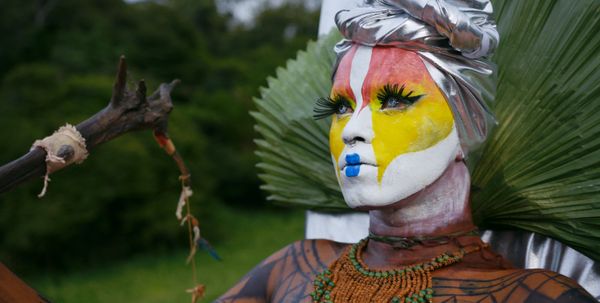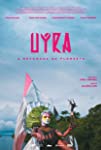Eye For Film >> Movies >> Uýra - The Rising Forest (2022) Film Review
Uýra - The Rising Forest
Reviewed by: Jennie Kermode

It’s hot in Brazil this year, as it is everywhere, every country feeling the strain of a warming planet – yet in the heart of the Amazon basin, in the forest, something unexpected: it’s much cooler. Certain plants, it is explained, shield the forest, keeping out the heat. Where it has been stripped away, leaving only bare, alien looking earth, fierce winds blow, but within the forest, there is stillness: other plants protect against the wind. In ruined buildings in the city of Manaus, and even amongst the factories, stubborn weeds sprout up, reclaiming their territory. Uýra reveals that one of them bears the name steel lung. Everywhere, there is resistance. The mother of the forest, the mother who is the forest, fighting back.
Uýra is amongst her servants, bringing her wisdom to a world which has never needed it more. A trained ecologist, she knows what she’s talking about, and even if you’ve studied in that field, there are revelations here which will surprise you. Although she has indigenous ancestry, her parents, absorbing the shame heaped on them by colonial culture, never taught her the old stories. She calls this ethnocide, the destruction of traditional ways of being. She has spent her life recovering them and, by blending them with scientific knowledge and art, she is communicating them to new generations.

This film, directed by Juliana Curi but, Curi insists, very much a team creation with Uýra herself taking a leading role, opens with one of the artist’s incredible dance performances, which immediately demonstrates her talent and gives the film something of a magical quality. It also helps to establish one of the film’s key messages, which is that our ways of thinking matter and that by changing them we can affect real change in the world. In a later scene, where we observe one of her workshops in the forest, a participant points out how simply wearing an earring can change the way one sees oneself, which is an experience which most people will be able to relate to. Many of Brazil’s indigenous peoples use face and body paint in this transformative way, and Uýra is introducing this art to the masses.
She is a brilliant costumer, inspiring her students to use whatever is around them. In one performance, she uses pain and found materials to transform herself into a green serpent-like creature, echoing a traditional story and, by way of this, attracting considerable public attention to the pollution in Mindú Creek, on which many people in Manaus depend for their water. Local people talk about their impressions of this and the way the water used to be, the old sharing their memories, the children sharing stories they have heard. Elsewhere, black and white pictures illustrate public efforts to resist logging, mines, pipelines, dams. In the city, the authorities pour concrete over indigenous graves.
“Brazil is the country which most kills environmentalists and trans people,” it is explained. Uýra is both – indigenous Amazonians seeing the world in a far less binary way – and she provides so much hope and inspiration to those around her that it’s easy to see how she gets under the skin of the likes of Jair Bolsonaro. A world away from the macho culture which rejects art, endeavours to ignore climate change and lives in fear of expressing anything which might appear feminine, Uýra has a different but very real kind of power. She speaks of the mother of the forest as a creator goddess, “a kind of energy”, capable of spectacular feats of endurance and renewal whilst those who harm her all eventually disappear. She has a message of hope for the whole world, but her own survival, and those of others doing similar work, could very well depend on this film. It is a cry for recognition from people who are often pushed out of sight, and the bigger its audience, the harder it becomes for anyone to make them disappear. but don’t just see it for that reason. See it because it’s brilliantly made; see it because it’s one of those rare pieces of cinema which could permanently change the way you think.
Reviewed on: 27 Jul 2022














